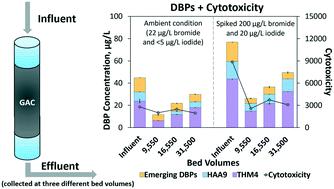当前位置:
X-MOL 学术
›
Environ. Sci.: Water Res. Technol.
›
论文详情
Our official English website, www.x-mol.net, welcomes your
feedback! (Note: you will need to create a separate account there.)
Treating water containing elevated bromide and iodide levels with granular activated carbon and free chlorine: impacts on disinfection byproduct formation and calculated toxicity
Environmental Science: Water Research & Technology ( IF 3.5 ) Pub Date : 2020-11-12 , DOI: 10.1039/d0ew00523a Chuhui Zhang 1, 2, 3, 4 , J. Clark Maness 1, 2, 3, 4, 5 , Amy A. Cuthbertson 4, 6, 7, 8, 9 , Susana Y. Kimura 4, 6, 7, 8, 10 , Hannah K. Liberatore 4, 6, 7, 8, 11 , Susan D. Richardson 4, 6, 7, 8 , Benjamin D. Stanford 4, 12, 13 , Mei Sun 4, 9, 14, 15 , Detlef R. U. Knappe 1, 2, 3, 4
Environmental Science: Water Research & Technology ( IF 3.5 ) Pub Date : 2020-11-12 , DOI: 10.1039/d0ew00523a Chuhui Zhang 1, 2, 3, 4 , J. Clark Maness 1, 2, 3, 4, 5 , Amy A. Cuthbertson 4, 6, 7, 8, 9 , Susana Y. Kimura 4, 6, 7, 8, 10 , Hannah K. Liberatore 4, 6, 7, 8, 11 , Susan D. Richardson 4, 6, 7, 8 , Benjamin D. Stanford 4, 12, 13 , Mei Sun 4, 9, 14, 15 , Detlef R. U. Knappe 1, 2, 3, 4
Affiliation

|
We evaluated the efficacy of granular activated carbon (GAC) adsorption for mitigating formation of chlorine disinfection byproducts (DBPs) in water with a wide range of bromide (20–1000 μg L−1) and iodide (<5–100 μg L−1) concentrations. GAC effectiveness was assessed by determining speciated total organic halogen (TOX), 70 DBPs, and calculated cyto- and genotoxicity. Overall, GAC treatment effectively lowered formation of TOX and the majority of targeted DBPs over the evaluated service time (>30 000 bed volumes). In the GAC influent, total organic bromine increased from 10 to 84% of TOX as bromide levels increased from 20 to 1000 μg L−1. Dissolved organic carbon (DOC) removal by GAC increased the bromide-to-DOC (Br/DOC) concentration ratio in GAC effluent relative to influent. As a result, bromine incorporation into DBPs increased after GAC treatment, especially at early GAC service times and low bromide levels. Total organic iodine was <3.5% of TOX, and iodo-DBP formation was low because elevated iodide was only evaluated in the presence of high bromide and free chlorine, a scenario that favors iodate formation. Although trihalomethanes (THMs) and haloacetic acids (HAAs) consistently formed at the highest molar concentrations, they were not major contributors to calculated cyto- and genotoxicity. Principal contributors to calculated cytotoxicity included haloacetaldehydes (HALs), haloacetamides (HAMs), and haloacetonitriles (HANs), while the main drivers of genotoxicity were HALs, HAMs, HANs, and halonitromethanes (HNMs) despite lower concentrations. Because bromine incorporation into DBPs increased nonlinearly with increasing Br/DOC concentration ratios, GAC more effectively controlled calculated toxicity at elevated bromide levels. Calculated cyto- and genotoxicity did not vary strongly with GAC service life, suggesting that GAC treatment can effectively lower calculated toxicity over long periods of operation. The majority of TOX remained unknown (>50%) in all samples despite the quantification of 70 DBPs targeted in this study, highlighting the need to assess toxicity associated with unknown DBPs.
中文翻译:

用颗粒状活性炭和游离氯处理含溴和碘含量升高的水:对消毒副产物形成和计算出的毒性有影响
我们评估了颗粒状活性炭(GAC)吸附对减轻含溴化物(20–1000μgL -1)和碘化物(<5–100μgL -1的水)中氯消毒副产物(DBP)形成的功效。)浓度。通过确定特定的总有机卤素(TOX),70个DBP以及计算的细胞毒性和基因毒性来评估GAC的有效性。总体而言,在评估的服务时间内(> 30000床体积),GAC处理有效地降低了TOX的形成和大多数目标DBP的形成。在GAC进水中,随着溴化物水平从20μgL -1增加,总有机溴从TOX的10%增加到84%。GAC去除溶解有机碳(DOC)相对于进水增加了GAC废水中溴化物与DOC(Br / DOC)的浓度比。结果,在GAC处理后,DBP中的溴掺入量增加,尤其是在GAC服役时间较早且溴化物含量较低的情况下。总有机碘含量不到TOX的3.5%,碘-DBP的形成很低,因为仅在高溴化物和游离氯存在下才评估碘化物升高,这种情况有利于碘酸盐的形成。尽管三卤甲烷(THMs)和卤乙酸(HAA)始终以最高摩尔浓度形成,但它们并不是计算出的细胞毒性和基因毒性的主要贡献者。计算出的细胞毒性的主要贡献者包括卤乙醛(HAL),卤乙酰胺(HAMs)和卤乙腈(HANs),尽管浓度较低,但遗传毒性的主要驱动因素是HAL,HAM,HAN和卤代硝基甲烷(HNM)。由于溴与DBP的结合随着Br / DOC浓度比的增加而非线性增加,因此GAC可以更有效地控制溴化水平升高时的计算毒性。计算出的细胞毒性和遗传毒性在GAC使用寿命中变化不大,这表明GAC治疗可以在长期手术中有效降低计算出的毒性。尽管对本研究中靶向的70种DBP进行了定量,但所有样品中的大多数TOX仍然未知(> 50%),这突出表明需要评估与未知DBP相关的毒性。由于溴与DBP的结合随着Br / DOC浓度比的增加而非线性增加,因此GAC可以更有效地控制溴化水平升高时的计算毒性。计算出的细胞毒性和遗传毒性在GAC使用寿命中变化不大,这表明GAC治疗可以在长期手术中有效降低计算出的毒性。尽管对本研究中靶向的70种DBP进行了定量,但所有样品中的大多数TOX仍然未知(> 50%),这突出表明需要评估与未知DBP相关的毒性。由于溴与DBP的结合随着Br / DOC浓度比的增加而非线性增加,因此GAC可以更有效地控制溴化水平升高时的计算毒性。计算出的细胞毒性和遗传毒性在GAC使用寿命中变化不大,这表明GAC治疗可以在长期手术中有效降低计算出的毒性。尽管对本研究中靶向的70种DBP进行了定量,但所有样品中的大多数TOX仍然未知(> 50%),这突出表明需要评估与未知DBP相关的毒性。
更新日期:2020-11-13
中文翻译:

用颗粒状活性炭和游离氯处理含溴和碘含量升高的水:对消毒副产物形成和计算出的毒性有影响
我们评估了颗粒状活性炭(GAC)吸附对减轻含溴化物(20–1000μgL -1)和碘化物(<5–100μgL -1的水)中氯消毒副产物(DBP)形成的功效。)浓度。通过确定特定的总有机卤素(TOX),70个DBP以及计算的细胞毒性和基因毒性来评估GAC的有效性。总体而言,在评估的服务时间内(> 30000床体积),GAC处理有效地降低了TOX的形成和大多数目标DBP的形成。在GAC进水中,随着溴化物水平从20μgL -1增加,总有机溴从TOX的10%增加到84%。GAC去除溶解有机碳(DOC)相对于进水增加了GAC废水中溴化物与DOC(Br / DOC)的浓度比。结果,在GAC处理后,DBP中的溴掺入量增加,尤其是在GAC服役时间较早且溴化物含量较低的情况下。总有机碘含量不到TOX的3.5%,碘-DBP的形成很低,因为仅在高溴化物和游离氯存在下才评估碘化物升高,这种情况有利于碘酸盐的形成。尽管三卤甲烷(THMs)和卤乙酸(HAA)始终以最高摩尔浓度形成,但它们并不是计算出的细胞毒性和基因毒性的主要贡献者。计算出的细胞毒性的主要贡献者包括卤乙醛(HAL),卤乙酰胺(HAMs)和卤乙腈(HANs),尽管浓度较低,但遗传毒性的主要驱动因素是HAL,HAM,HAN和卤代硝基甲烷(HNM)。由于溴与DBP的结合随着Br / DOC浓度比的增加而非线性增加,因此GAC可以更有效地控制溴化水平升高时的计算毒性。计算出的细胞毒性和遗传毒性在GAC使用寿命中变化不大,这表明GAC治疗可以在长期手术中有效降低计算出的毒性。尽管对本研究中靶向的70种DBP进行了定量,但所有样品中的大多数TOX仍然未知(> 50%),这突出表明需要评估与未知DBP相关的毒性。由于溴与DBP的结合随着Br / DOC浓度比的增加而非线性增加,因此GAC可以更有效地控制溴化水平升高时的计算毒性。计算出的细胞毒性和遗传毒性在GAC使用寿命中变化不大,这表明GAC治疗可以在长期手术中有效降低计算出的毒性。尽管对本研究中靶向的70种DBP进行了定量,但所有样品中的大多数TOX仍然未知(> 50%),这突出表明需要评估与未知DBP相关的毒性。由于溴与DBP的结合随着Br / DOC浓度比的增加而非线性增加,因此GAC可以更有效地控制溴化水平升高时的计算毒性。计算出的细胞毒性和遗传毒性在GAC使用寿命中变化不大,这表明GAC治疗可以在长期手术中有效降低计算出的毒性。尽管对本研究中靶向的70种DBP进行了定量,但所有样品中的大多数TOX仍然未知(> 50%),这突出表明需要评估与未知DBP相关的毒性。











































 京公网安备 11010802027423号
京公网安备 11010802027423号